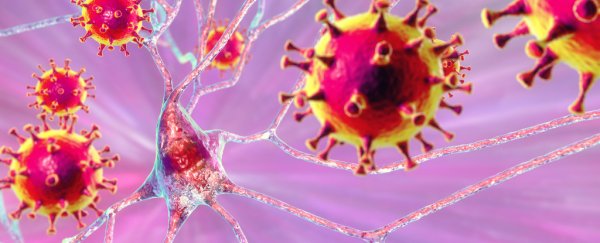Herpes simplex is the criminal genius of viruses, breaking into the cells lining our more delicate body parts before finding their way into our nervous system, where it hides itself in our DNA. Precisely how they carry out this complicated hijacking sequence is only partially understood.
Now a study led by researchers from the Northwestern University Feinberg School of Medicine in the US has uncovered a vital piece of the puzzle, one that could potentially point the way to new ways to treat or even prevent this incredibly common disease.
Herpes is an all-too-familiar infection to most of the world's population, whether they know it or not. Found in more than two thirds of all humans as the type-1 oral variety (HSV-1) or the sexually-transmitted type-2 (HSV-2) form, it's been an intimate companion for our species for as long as we've been human. Maybe even longer.
Though usually silent, the virus is capable of producing some downright uncomfortable and even destructive symptoms, from the ubiquitous cold-sore blisters to the rare but devastating effect it can have when it invades the eye.
In some of the most tragic cases, passing the infection from mother to child can be fatal for a newborn. Shockingly, more than a thousand infant deaths in the US have been attributed to the disease over the past two decades alone.
It's even been implicated as a cause, or at least contributing factor, in cases of dementia.
Getting our hands on a reliable treatment, if not a vaccine, would bring a lot of relief and safety to people around the globe.
Unfortunately, the herpes virus is a wily one, exposing itself to our immune system for the briefest period before inserting its DNA into the genetic library of our peripheral nerve cells. There it remains, a recipe for disaster begging to be translated into a new generation of infectious particles the moment the heat dies down.
"It reprograms the cell to become a virus factory," says Northwestern Medicine immunologist Gregory Smith.
"The big question is how does it get to the nucleus of a neuron?"
A clue lies in a protein encoded by the virus, called pUL36. Previous research revealed the protein can lock onto molecules of dynein – tiny biological motors that click-clack their way along the web of stiff strings that help give a cell its shape.
To put it another way, herpes seems to make its way around the inside of any cell it invades by hitching a ride on the cell's own rail network, care of its own tiny grappling hook.
Observations on various other cells revealed there had to be more to the story, however. In some tissues, the rail journey wasn't random, or even in a single direction. The virus was able to take a trip to the cell's periphery, a journey that couldn't be explained by a dynein ride alone.
Yet the herpes virus didn't seem to make anything else that could help it navigate the network.
Now the researchers have shown that the virus simply steals a tool from the original cells it breaks into. This additional molecular device, a motor protein called kinesin, literally walks along the strings of microtubules that support the cell.
Using both dynein and kinesin to move around inside a cell isn't necessarily unusual for a virus. What is clever is that herpes takes one half of this set from one cell type and uses it in another in order to move more efficiently.
Further examination showed how this theft helped the virus make its way to the nucleus of a nerve cell. Once it entered the neuron's body it was able to take an express straight to DNA central without risking the added delay of randomly zig-zagging back and forth.
A nerve cell might not seem big to us, but for a virus ratcheting its way along weaving strands of cellular webbing is a lengthy one.
"It's a long way to go," says Smith. "It probably takes eight hours for it to travel from the end of the neuron to the hub."
It's the first time a virus has been seen repurposing a protein to help it continue its infection, a discovery that could help us better understand our relationship with this ancient pathogen and maybe even find a way to lock it out of our DNA.
"By learning how the virus is achieving this incredible feat to get into our nervous system, we can now think about how to take away that ability," says Smith.
"If you can stop it from assimilating kinesin, you would have a virus that couldn't infect the nervous system. And then you have a candidate for a preventive vaccine."
This research was published in Nature.
